 |
 |
 |
 |
 |
|


June 19, 2009
In its childhood, science was an amateur activity. Grown men and women collected shells or beetles, pressed and sketched plants, peered
through telescopes or microscopes, and had a good chance of discovering something new.

But grown-up science has become quite forbidding to anyone with math anxiety and without a Ph.D. The massive, intricate instruments and
the supercomputers that run them are light-years removed from the hands-on tools and direct immersion in nature that made early science
an accessible adventure. These days if you love science, you either spend years in preparation and specialization, or you love it from afar. Right?

So how did a twenty-four-year-old Dutch schoolteacher discover a new intergalactic phenomenon within a week of beginning to do astronomy?
Read about the new phenomenon in which “civilians” become the footsoldiers of science—and sometimes even its heroes. It could happen to you.. more



June 3, 2009
After its successful final servicing mission, the Hubble Space Telescope appears to be better than ever. But the triumph was bittersweet as astronauts released the Hubble from their grasp for the last time—and faced the uncertain future of human (versus robotic) space exploration. Thanks to a book reviewed in our October 2008 issue, I couldn’t help flashing back to the first Hubble servicing mission, in 1993—the one that turned Hubble from “what might be the greatest catastrophe to hit American astronomy ever” into a triumph . . . and a turning point in human evolution. more



March 20, 2009
You’ve heard about “crunchy cons”—conservative and evangelical Christian environmentalists who preach stewardship of the Creation, even going so far as to forge an alliance with agnostic (at best) scientist E.O. Wilson. Well, now Malaysia has crunchy mullahs. Following up on well-received sermons exhorting the faithful to protect enangered turtles, some mosques will feature sermons—crafted in collaboration with the World Wildlife Fund—that find grounds in Quranic scripture to protect tigers and elephants and their habitat. more



Febrary 23, 2009
Charles Darwin is an icon; he is, to many of us, more of a meme than a man. He came to life for me for really the first time in the course of fact checking this month’s marvelous 200th-birthday tribute, Richard Milner’s “Seeing Corals with the Eye of Reason.” No accident: Milner, an NH contributing editor, has virtually dedicated his life to bringing the real Charles Darwin back alive. Here are a few of the things I didn’t know about Darwin that you may or may not, from his oft-misrepresented thought to his beguiling humanity. In this 200th year of his birth and profound, pervasive influence on our world, there’s no more fitting celebration than to get to know him, or to know him better. more




Febrary 5, 2009
Kin selection as an explanation for the evolution of altruism seems so intuitively right that it’s hard to accept that it’s wrong, but that’s what the eminent sociobiologist E.O. Wilson—a former believer—has concluded. Plenty of other eminent scientists, such as Richard Dawkins, still disagree with him.

If not kin selection, then what is driving the development of the remarkable degree of self-sacrifice in these colonies? Wilson, as his new Superorganism book with Hölldobler, and Dunn’s review of it, make clear, has become a convert to the idea of group selection in social insects . . . and possibly in human societies, too. more




Febrary 3, 2009
How do you pass on a gene for self-sacrifice? It sounds like an oxymoron. “All the way up and down the evolutionary scale, from single-celled amoebas to human beings, the persistence of a tendency to help others at one’s own expense is a conundrum for natural selection,” wrote Joan E. Strassman and David C. Queller in their September 2007 article, “Altruism Among Amoebas”:
If an individual does not pass on its genes to offspring, for whatever reason, those genes will be that much scarcer in the next generation. The process is blind, ruthless, and competitive, and it would seem to shut the door on genes for altruism. . . . [H]ow can self-sacrifice be a successful strategy?
Since I’ve been working for Natural History, we’ve run what adds up, in my mind, to a series of articles on this conundrum, ranging all the way up and down the evolutionary scale—and sometimes across species boundaries. more



January 7, 2009
To accompany our December-January story on the pioneering paleoartist Benjamin Waterhouse Hawkins, the following letters and newspaper reports document the rise and fall of the great prehistoric beasts of Central Park—genteel behemoths rent limb from limb by a more bloodthirsty breed, graftivorous politicians. more



January 3, 2009
The Man Who Planted Trees, a beautiful 1987 animated film, can be watched for free online. Itís about half an hour long, absolutely riveting, beautifully drawn, and very moving. Besides that, itís an object lesson in the life-giving, reverberating power of the simple act of planting trees. more



(Annie Gottlieb) |
|
|
 |
 |
 |
 |
|
 |
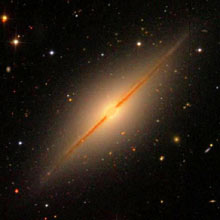

Sloan Digital Sky Survey (SDSS) Object Of The Day, July 27, 2007


Hubble Space Telescope is released from cargo bay of space shuttle Atlantis.

From Atlantis crew video
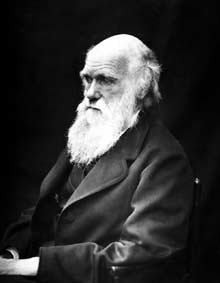

Charles Darwin in his later years. Photo by J. Cameron, 1869.

Wikimedia Commons


Richard Dawkins

Source: TimesOnline
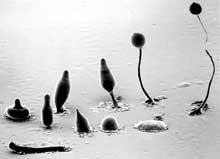

Hungry Dictyostelium amoebas

© M.J. Grimson & R.L. Blanton,
Texas Tech University
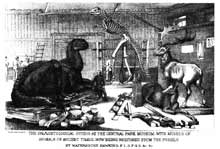

The Hawkins studio at the
Central Park Museum

Central Park Commission Annals
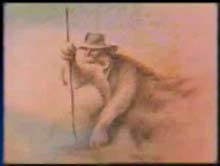

Still from The Man Who Planted Trees
|
 |








